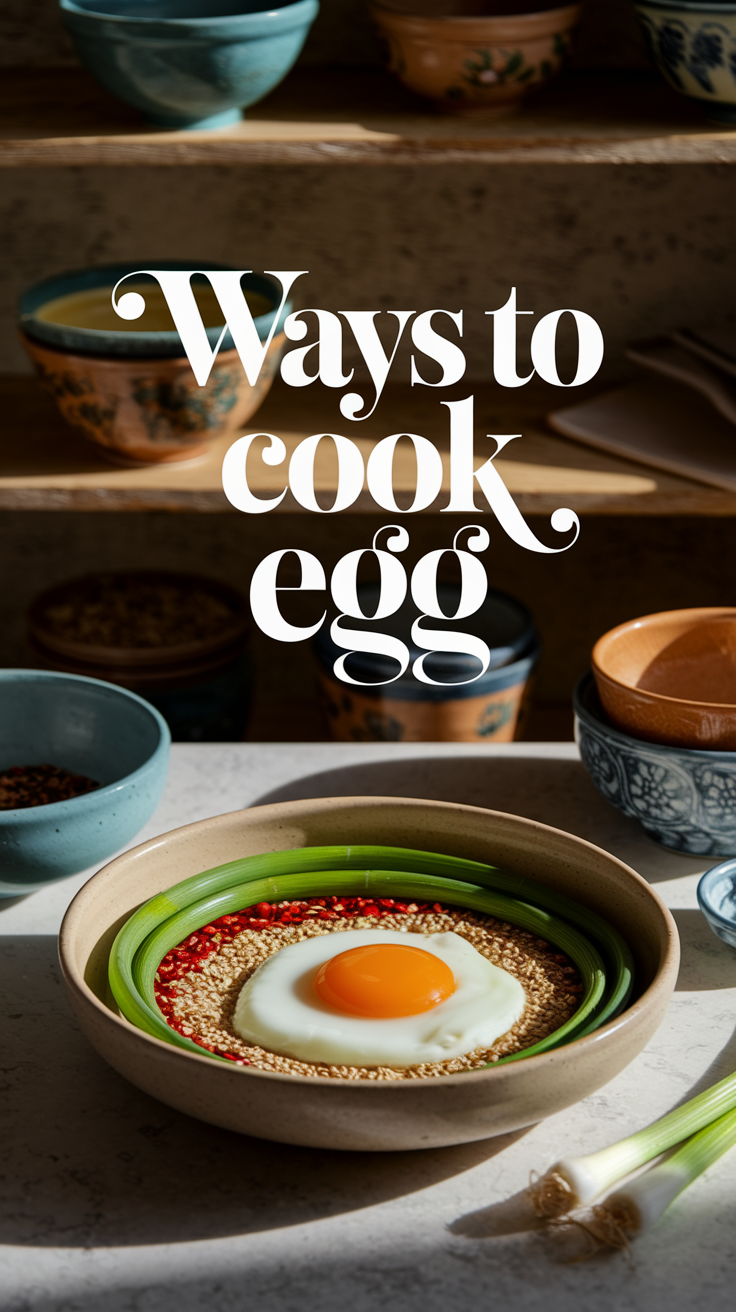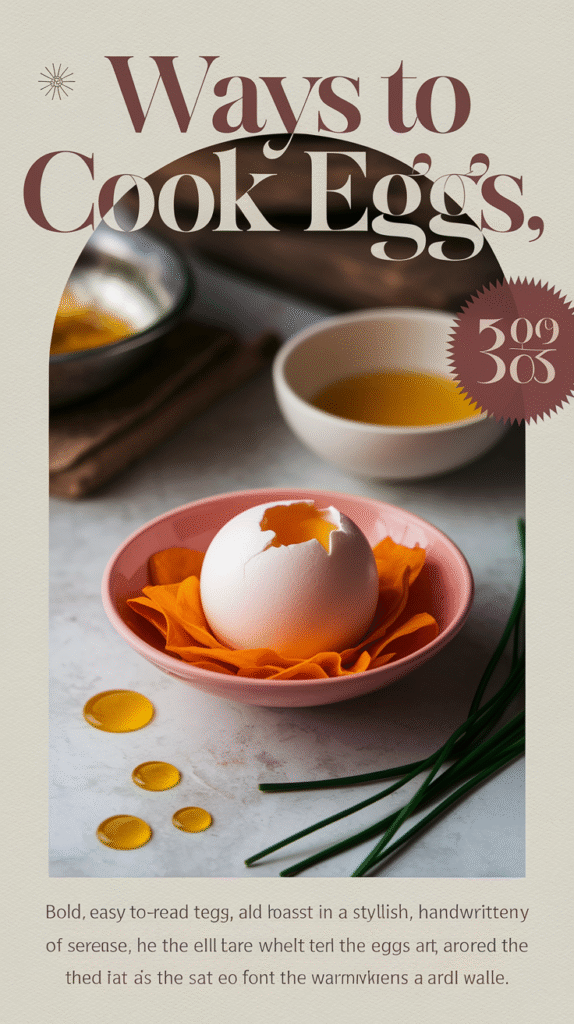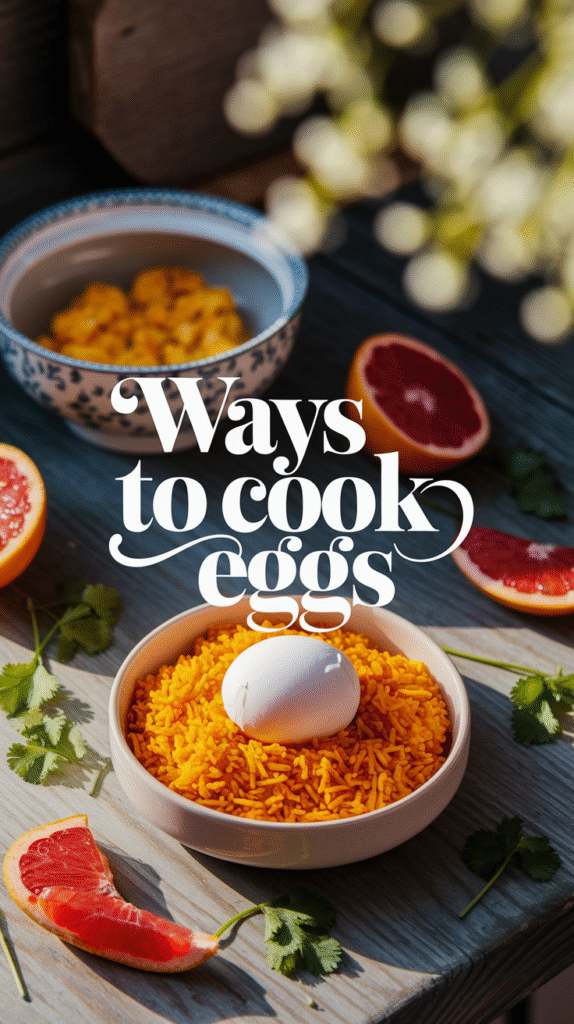Cooking eggs can be an exciting culinary journey, with numerous techniques to explore. Whether you prefer them soft and runny or cooked to perfection, there’s a method that fits everyone’s palate. Here, we dive into creative ways to cook eggs that will elevate your breakfast, lunch, or dinner, appealing to taste buds of all ages.
Boiled Eggs
Boiling eggs is straightforward yet allows for various textures. Here are two popular methods:
- Soft-Boiled: Cook for 4-6 minutes. The egg whites will be firm, while the yolk remains creamy and runny, perfect for dipping toast.
- Hard-Boiled: Cook for 9-12 minutes. This method makes the yolk firm, yielding a great option for salads or as a snack. You can easily make your own egg salad by mixing chopped hard-boiled eggs with mayo, mustard, and seasonings.
Scrambled Eggs
Scrambled eggs can be adapted to fit any dietary need. Here are two fun variations:
- Classic Scramble: Whisk eggs with salt and pepper, then cook them gently in butter, stirring frequently. This yields soft and fluffy eggs.
- Cheese Scramble: Add shredded cheese during the cooking process for a creamy, cheesy goodness. Popular choices include cheddar or feta, which add outstanding flavor.
Fried Eggs
Fried eggs can be cooked to your liking, with two traditional styles:
- Sunnyside Up: Cook without flipping, keeping the yolk runny. Serve on toast for a simple, yet tasty, breakfast.
- Over-Easy: Flip the egg to cook the yolk slightly, retaining some of that delicious gooeyness. Serve over rice or on a burger for a delightful addition.
Omelettes and Frittatas
Omelettes and frittatas provide endless possibilities when it comes to fillings. Here’s a breakdown:
- Omelettes: Beat eggs and cook in a skillet with your choice of fillings like spinach, tomatoes, mushrooms, or ham. Fold over and serve with a sprinkle of cheese on top.
- Frittatas: Similar to omelettes but thicker and cooked in the oven. Mix eggs with vegetables, meat, and cheese, then bake until set. Enjoy cold as leftovers!
Baked Eggs
Baked eggs, or Shakshuka, can be a healthy and flavorful option. Here’s how to whip up this dish:
- Start by sautéing onions, garlic, and bell peppers in a pan.
- Add diced tomatoes and seasonings like cumin and paprika; let it simmer.
- Crack eggs into the mixture and cover the pan until the eggs are cooked to your desired doneness.
- Serve hot with crusty bread for dipping.
Poached Eggs
Poaching eggs results in delicate flavors and textures. To achieve the perfect poached egg, follow these simple steps:
- Bring a pot of water to a gentle simmer and add a splash of vinegar.
- Crack an egg into a small bowl.
- Stir the simmering water to create a whirlpool and gently slide the egg into the center.
- Cook for 3-4 minutes or until the whites are set but the yolk remains runny.
Poached eggs are delightful on top of salads or served over avocado toast.
Global Egg Dishes
Explore global egg dishes that bring unique flavors to your table:
- Spanish Tortilla: A thick omelette with potatoes and onions, cooked slowly for depth of flavor. Pair with a fresh salad.
- Egg Curry: Hard-boiled eggs simmered in a spiced tomato and onion gravy, perfect with rice or naan.
- Menemen: A Turkish breakfast dish made with scrambled eggs, tomatoes, peppers, and spices served with crusty bread.
With these creative ways to cook eggs, you can explore different techniques and styles that not only enhance your meals but also give you a chance to experiment in the kitchen. Whether you’re preparing breakfast for yourself or hosting friends, eggs are a versatile and nutritious option.
For additional recipes and egg inspiration, visit Eggland’s Best or explore unique dishes at Food Network.
The Nutritional Benefits of Different Egg Cooking Methods
Eggs are a universal staple found in many diets around the world. Not only are they versatile, but they offer a wealth of nutritional benefits that vary depending on the cooking method used. When considering the best ways to enjoy eggs, it’s essential to look at how different cooking techniques affect their nutritional value.
Boiling Eggs
Boiling eggs is one of the simplest and healthiest methods. This technique preserves most of the nutrients, making boiled eggs a powerhouse of protein, vitamins, and minerals. Boiling eggs can be done hard or soft:
- Hard-boiled: Fully cooked with a firm yolk and white. Hard-boiled eggs contain about 6 grams of protein and are rich in vitamin D, B6, B12, and minerals like zinc and iron.
- Soft-boiled: The yolk remains runny. This method retains more nutrients, giving you a rich source of choline, which is vital for brain health.
Scrambling Eggs
Scrambling eggs is another popular method, but it’s essential to be mindful of the additional ingredients you may use, such as butter or milk. A basic scrambled egg dish can still be incredibly nutritious:
- Provides about 7 grams of protein per egg.
- Eggs retain their nutrients well, making them an excellent choice for breakfast.
- Additions like spinach or tomatoes enhance their vitamin content. For instance, spinach adds iron and vitamin K, while tomatoes offer vitamin C.
Frying Eggs
Fried eggs can be delicious, but they may not be as healthy as some other cooking methods, especially if you use a lot of oil or butter. The type of fat you choose plays a significant role:
- Healthy fats: Using olive oil or avocado oil can provide healthy monounsaturated fats.
- Cooking style: Try sunny-side-up or over-easy to minimize cooking time and nutrient loss.
A fried egg still provides about 6 grams of protein and retains many vitamins and minerals. Keep portions in check to avoid excess calories from fat.
Baking Eggs
Baked eggs have gained popularity, especially in dishes like quiche or shakshuka. This cooking method allows for creative meal preparation and can be incredibly nutritious, especially with the right ingredients:
- Combining eggs with vegetables boosts the fiber and nutrient content.
- Baking maintains most of the nutrients found in eggs, similar to boiling.
Baked dishes can be enhanced with ingredients like cheese, but consider moderation to keep saturated fat levels in check.
Poaching Eggs
Poached eggs are an elegant, low-calorie option that retains most nutrients. Cooking eggs gently in water prevents them from absorbing unnecessary fats:
- Poached eggs contain around 6 grams of protein with minimal added calories.
- This method is excellent for keeping the yolk runny, maximizing the absorption of choline.
Nutritional Comparison Table
| Cooking Method | Protein (grams/egg) | Fat (grams/egg) | Calories | Nutrients |
|---|---|---|---|---|
| Hard-boiled | 6 | 5 | 68 | Vitamin D, B12 |
| Scrambled | 7 | 9 | 90 | Choline, Vitamin A |
| Fried | 6 | 7 (with oil) | 90 | Vitamin D, B12 |
| Baked | 6 | 5 (varies with ingredients) | 70-100 | Vitamins depends on additions |
| Poached | 6 | 5 | 68 | Choline, Selenium |
With so many ways to cook eggs, you can easily find methods that suit your taste while maximizing nutritional benefits. Whether you prefer them scrambled, poached, or baked, eggs are an essential addition to your diet. For more detailed nutritional information, consider checking resources like Healthline and Egg Nutrition Center for comprehensive data on the benefits of eggs.
Tips for Perfecting Poached Eggs Every Time
Poaching eggs can seem tricky, but with a few simple tips, you can achieve that perfectly runny yolk and delicate white every time. Whether it’s for breakfast, brunch, or a fancy dinner, mastering this cooking technique is a rewarding skill. Here are essential steps to perfect poached eggs.
Choosing the Right Eggs
The quality of your eggs matters. For the best poached eggs, use fresh, high-quality eggs. Fresh eggs have firmer whites that hold their shape better when poaching. Look for eggs with a recent sell-by date, as they typically are fresher. Organic or free-range eggs are also great options since they tend to have richer flavors.
Preparing the Water
Water preparation is key to poaching eggs perfectly. Here’s how to do it:
- Fill a shallow pot or a deep skillet with water, about 3-4 inches deep.
- Bring the water to a gentle simmer. Look for small bubbles forming on the bottom but don’t let it boil vigorously.
- Add a splash of vinegar to the water. This helps the egg whites to coagulate quickly and stay together while cooking. Use about 1 tablespoon of vinegar per quart of water.
Creating the Vortex
To keep the egg whites from spreading in the water, create a gentle whirlpool. Use a spoon to stir the water in one direction until you get a nice vortex.
Cracking the Eggs
When you’re ready to poach, crack each egg individually into a small bowl. This allows you to check for shell pieces and also makes it easier to slide the egg into the water gently.
Cooking the Eggs
Here’s a step-by-step guide:
- Lower the heat to maintain a gentle simmer.
- Carefully drop the egg into the center of the vortex, gently and close to the water’s surface.
- Let the egg cook for about 3-4 minutes for a soft, runny yolk. Adjust the time based on your preference for doneness.
- Use a slotted spoon to remove the egg from the pot and transfer it to a plate lined with a paper towel to drain excess water.
Tips for Success
Here are some extra tips to ensure perfect poached eggs:
| Tip | Description |
|---|---|
| Temperature | Keep the water at a steady simmer. Too much movement can break apart the egg whites. |
| Batching | When cooking multiple eggs, poach them one or two at a time to make it easier to manage. |
| Timing | Use a timer for consistency. Experiment a little to find your preferred cooking time. |
| Resting | If making ahead, place the poached eggs in a bowl of cold water for a few minutes. Reheating in simmering water before serving helps. |
Serving Suggestions
Poached eggs are versatile and can be served in various delicious ways:
- On toast with smashed avocado and a sprinkle of salt.
- Over mixed greens for a light salad.
- With smoked salmon for a luxurious brunch.
- In a classic Eggs Benedict with hollandaise sauce.
Experiment with various flavors and styles to find your favorite combination. For more ideas on eggs and how to prepare them, check out Epicurious and Serious Eats.
Final Thoughts
Now that you have the tips and tricks for perfecting poached eggs, grab some fresh eggs and start practicing! With a little patience, you will create beautiful, delicious poached eggs every time. Enjoy this simple yet rewarding cooking technique in your kitchen today.
Global Egg Dishes: A Culinary Tour Around the World
Eggs are a versatile ingredient used in dishes worldwide. Each culture offers a unique take on how to cook and enjoy this nutritious food. Let’s embark on a culinary journey that highlights popular egg dishes from different countries, showcasing their flavors and traditions.
Shakshuka – North Africa and the Middle East
Shakshuka is a delightful dish of poached eggs in a spicy tomato sauce. Originating from Tunisia, it has become a breakfast staple in many Middle Eastern countries. The dish consists of:
- Tomatoes
- Chili peppers
- Onions
- Spices such as cumin and paprika
Served with bread, Shakshuka is both hearty and healthy. This meal can be easily customized by adding ingredients like feta cheese or vegetables.
Spanish Tortilla – Spain
In Spain, the Spanish tortilla, or “tortilla de patatas,” is a beloved dish made with eggs, potatoes, and onions. This thick, hearty omelet is cooked slowly to create a soft center. It can be served warm or cold, making it perfect for any meal. A few tips for making a great Spanish tortilla include:
- Using high-quality potatoes, such as Yukon golds.
- Carefully sautéing the onions for sweetness.
- Letting the tortilla rest before slicing to allow the flavors to meld.
Huevos Rancheros – Mexico
Huevos Rancheros is a traditional Mexican breakfast dish featuring fried eggs served on corn tortillas and topped with salsa. This dish is colorful and full of flavor, typically made with:
- Freshly made salsa or pico de gallo
- Refried beans
- Avocado slices or guacamole
Each region in Mexico may have its own take on this dish, often including additional toppings like cheese or jalapeños.
Oyakodon – Japan
Oyakodon is a comforting Japanese bowl dish that translates to ‘parent-and-child donburi.’ It features chicken and eggs cooked together in a sweet soy sauce broth, served over rice. The key ingredients include:
- Chicken thighs or breast
- Eggs, lightly beaten
- Soy sauce, mirin, and dashi broth
This dish is a wonderful example of homestyle Japanese cooking and brings a unique flavor profile that is both savory and slightly sweet.
Egg Curry – India
Indian cuisine features a spicy and aromatic egg curry, often served with rice or flatbreads like naan. The dish is characterized by:
- Hard-boiled eggs cut in half
- A rich curry sauce made from tomatoes, onions, and various spices
- Fresh coriander leaves for garnish
The complex blend of spices can vary by region, making this dish incredibly diverse.
Frittata – Italy
Frittata is a type of Italian omelet enriched with vegetables, meats, and cheese. Unlike traditional omelets, frittatas are cooked slowly on low heat and finished in the oven. Typical ingredients include:
- Eggs
- Spinach
- Peppers
- Cheeses such as mozzarella or parmesan
Frittatas can be served hot or at room temperature, making them a perfect dish for brunch or a picnic.
Exploring egg dishes from around the world reveals their cultural significance and diverse preparations. Each dish offers a unique taste experience and insight into local traditions. For more inspiration, check out resources like Saveur and Food Network.
Egg Cooking Hacks: Time-saving Tricks for Busy Cooks
Cooking eggs is a daily ritual for many, but if you’re a busy cook, you want to do it quickly and efficiently. Here are some clever hacks that can save you time while preparing delicious egg dishes.
Boiling Eggs Perfectly
If hard-boiled eggs are your go-to, there’s a quicker way to get them just right. Start by placing eggs in a single layer in a pot of cold water. Make sure the water covers the eggs by about an inch. Then, bring the water to a boil over medium-high heat. Once the water is boiling, cover the pot, turn off the heat, and let the eggs sit for:
- 4 minutes for soft-boiled
- 6 minutes for medium-boiled
- 9-12 minutes for hard-boiled
After resting, transfer the eggs to an ice bath for a few minutes to halt the cooking process and make them easier to peel. For an in-depth guide on boiling eggs, check out Egg Nutrition Center.
Microwave Scrambled Eggs
Short on time? Try making scrambled eggs in the microwave. It’s simple and quick:
- Crack 2 eggs into a microwave-safe bowl.
- Add a splash of milk or water for creaminess.
- Season with salt and pepper.
- Whisk together until well combined.
- Microwave on high for 30 seconds. Stir, then microwave for another 30 seconds. Continue until the eggs are cooked to your liking.
This method not only saves time but also reduces the cleanup effort. Always keep an eye on your eggs while they cook, as microwave power levels can vary.
Egg Muffins for Meal Prep
If you want a healthy breakfast ready to go, try egg muffins. They are perfect for meal prep and can be customized with your favorite ingredients. Here’s how to make them:
- Preheat your oven to 350°F (175°C).
- Grease a muffin tin.
- Whisk together eggs, chopped vegetables, meats, and cheese.
- Pour the mixture evenly into the tin, filling each cup about ¾ full.
- Bake for 20-25 minutes or until the eggs are set.
These muffin-style eggs can be refrigerated and reheated for a quick breakfast throughout the week.
Pressure-Cooked Eggs
Another fantastic time-saving hack is using a pressure cooker. This method ensures perfectly cooked eggs with minimal effort. Here’s how:
- Add 1 cup of water to the bottom of the pressure cooker.
- Place the eggs on the steamer rack or in an egg holder.
- Seal the pot and cook on high pressure for 5 minutes.
- Quick release the pressure, then transfer the eggs to an ice bath.
This technique not only cooks eggs quickly but also makes peeling easier thanks to the steam. For more tips on pressure-cooked eggs, visit Pressure Cook Recipes.
Poaching Eggs with Ease
Poaching eggs can be tricky, but here’s a simple trick. Instead of using a pot of simmering water, use a microwave:
- Fill a microwave-safe mug with ½ cup of water.
- Crack an egg into the water.
- Cover the mug with a microwave-safe plate.
- Microwave for about 1 minute or until the egg is set to your liking.
This method produces perfectly poached eggs without the mess of boiling water!
Storing Hard-Boiled Eggs
To save time later in the week, boil extra eggs and store them in the fridge. Keep them in their shells until you are ready to eat—they can last up to a week. When you’re ready, simply peel and enjoy! For more storage tips, visit Food Safety.
Cooking eggs doesn’t have to be a time-consuming task. With these hacks, you can enjoy delicious egg-based meals with less prep time. Happy cooking!
Conclusion
Eggs are a versatile and nutritious ingredient that can be prepared using countless techniques and styles. From traditional methods to innovative culinary twists, exploring creative ways to cook eggs opens up a world of flavors and textures. By understanding the nutritional benefits of various cooking methods, you can make more informed choices about how you enjoy this protein-packed food.
Mastering the art of poaching eggs can elevate your breakfast game, and with the tips shared in this article, you can achieve perfectly poached eggs every time. Additionally, taking a global culinary tour introduces you to unique egg dishes from different cultures, allowing you to experience the rich diversity the egg has to offer.
For those with busy schedules, egg cooking hacks can save you valuable time in the kitchen while still delivering delicious results. Whether you’re whipping up a quick scrambled egg or preparing a gourmet frittata, these time-saving techniques are perfect for any home cook.
Embrace the simplicity and elegance of eggs in your cooking routine. This incredible ingredient not only satisfies your hunger but also brings people together around the table. Whether you’re experimenting with new styles or perfecting classic recipes, the ways to cook eggs are virtually endless. Go ahead, get cracking, and enjoy all the delightful experiences that come from this beloved food!







Leave a Reply